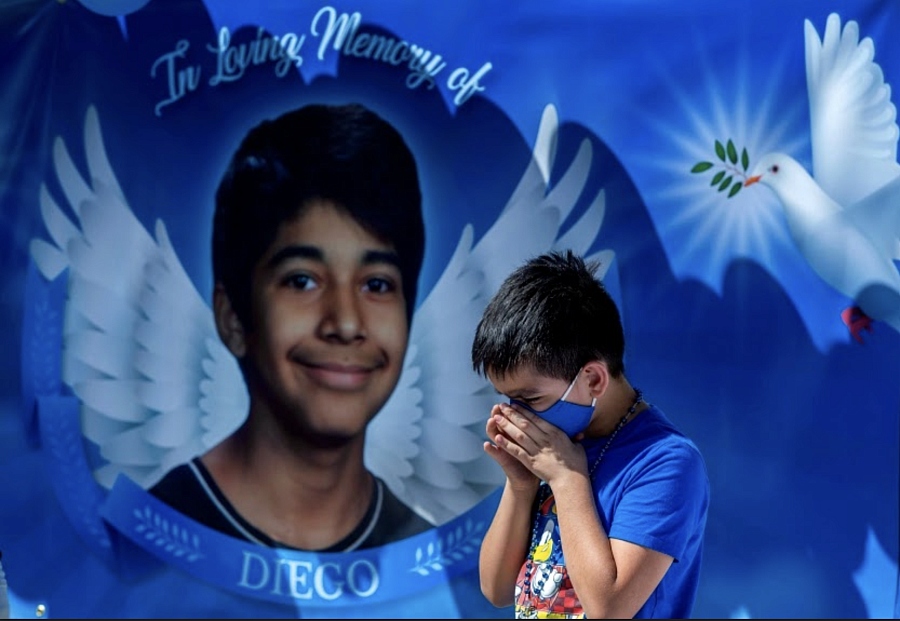Beating back bullying: What do successful schools districts share?

Eric Henry, a 9-year-old Moreno Valley boy, prays in front of a memorial for Diego Stolz, who was fatally assaulted in September 2019 at Landmark Middle School in Moreno Valley.
(Photo by Terry Pierson, The Press-Enterprise/SCNG)
When middle school student Rosalie Avila, 13, killed herself after being bullied by classmates, many in the community treated it as something no one could have prevented.
When middle school student Diego Stolz, 13, died from the injuries sustained in an on-campus attack by two classmates whom he had reported were bullying him the week before, community members said the only way to prevent such tragedies was to teach their children to fight in order to be able to savagely beat the bullies before they themselves were beaten.
But California school districts vary wildly in the rates of bullying faced by students, as anonymously reported by the students themselves.
According to the California Healthy Kids Survey, which is conducted in about 70% of California’s 1,037 public school districts, about a quarter of seventh graders in Irvine Unified in Orange County have experienced harassment or bullying and about 10% of them have been in a physical fight. In Alameda Unified in the Bay Area, 43% of seventh graders say they’ve been harassed or bullied and 18% of them have been in a physical fight. The disparities between districts don’t neatly line up with socioeconomic status or any other simple explanation. Something else is going on.
I first became aware of the treasure trove of data in the California Healthy Kids Survey in 2018, after four high school and middle school students in Rancho Cucamonga killed themselves in the first few weeks of the 2018-19 school year. In the process of trying to cover the awful news in a sensitive, responsible way, I encountered the work of Prof. Ron Avi Astor, now at UCLA. Astor and a co-author had looked at the disparities reported in the California Healthy Kids Survey in how many secondary students had reported considering killing themselves in the past year. Astor was — and I believe still is — frustrated at how little was being done with the data, which suggested all sorts of factors impacted how likely kids were to consider suicide.
So, in 2019, I did something about it. Using the most recent California Healthy Kids Survey data, I looked at the self-reported levels of suicidal thoughts among students in the Los Angeles region, discovering sometimes dramatic differences between districts, ranging from a low of 13% in Coachella Valley Unified to a high of 32% in Rowland Unified.
The disparities didn’t nicely track economic fault lines: In Rim of the World Unified, where schools are crumbling as enrollment plummets, only 14% of students said they had considered killing themselves. But in affluent Palos Verde Peninsula Unified, students were 9% more likely to think about suicide.
I wanted to write a story that went beyond a blame-and-shame article, which did not seem likely to prevent any student suicides. Instead, I interviewed officials at districts where students reported low levels of suicidal thoughts, as well as districts that had seen dramatic drops over the past five years. I found common elements in all of them, a set of mental and emotional health supports, sometimes offered for free by outside nonprofits to impoverished districts. The resulting story was passed back and forth between educators on social media and our internal metrics show that the entire package of stories continue to be read, two years later.
Now I want to do the same with bullying, looking at California school districts where students report low levels of bullying and fighting and see what programs they have in common. I want to create a package of stories under the auspices of the 2021 Data Fellowship that educators, parents and students can turn to, find programs that have a proven track record of working and replicate them across the state and nation.
Because I don’t think bullying is inevitable and I don’t believe that adults should just accept that more kids like Rosalie and Diego will die because of it.
**

